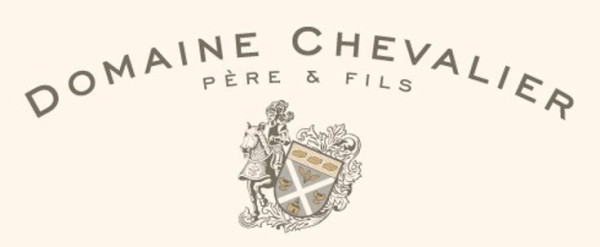
The Estate
Marcelle Dubois, along with his daughter and son-in-law, Emile Chevalier, inherited the estate just after WWI. Conscientious and meticulous, Emile Chevalier spent years of hard work perfecting the quality of the vines after the difficult years of the phylloxera crisis. His son, Georges, took over management after Emile and began to enlarge the estate and increase the prestige of Domaine Chevalier, beginning with the planting of 3 hectares of vines in Gamay.
Georges Chevalier learned quickly, not only because he loved this work, but because of his serious dedication to producing remarkable wines. In 1959, he decided to bottle all the harvests, the result being that since 1969, all wines sold to his customers were sold in bottles bottled on the estate. In 1975, Georges’ son Claude joined the family business, and continued to expand the estate by adding a further 11 hectares.
Since 1994, Claude, with the influence of his father, has concentrated solely on vinification of Estate wines. In 1998, he decided to change certain working methods in the vineyard, as well as the vinification process—new barrel selection, fermenting time, maturing time in barrels, filtration, etc.
Today, the estate is run by Claude Chevalier’s three daughters who represent the 5th generation of wine-growers in the Chevalier family: Chloé has been managing winegrowing and winemaking since 2008 after obtaining her Viticulture-Oenology BTS in Beaune; Julie, who has a diploma from the l’école de Commerce de Reims, directs sales and administration; and Anaïs, who joined her sisters in the business in 2012, handles accounting and welcoming customers to the winery.
The Location
Two hamlets share this Domaine of 266 hectares: Ladoix, which takes its name from the old French name “La Douix” (The Source) and Buisson, recognized since 1305 and former property of the Hospices de Beaune.
The southeastern exposure as well as its unique and exceptional position—at the northern tip of the Côte de Beaune and the edge of the Côte de Nuits—offers a nice hierarchy of AOC wines, which few villages can approach, with its AOC Burgundy red and white, AOC Villages red and white (120 ha), AOC Villages Premier Cru red and white (35 ha), and finally the AOC Grands Crus (29 ha) with the famous Corton red and Corton Charlemagne white.
It is thanks to the hard work of the winemakers and the quality of the wines they produce (very balanced and uniquely structured reds and whites with complex characteristics and superior aging potential) that Ladoix has gained notoriety, which it richly deserves.
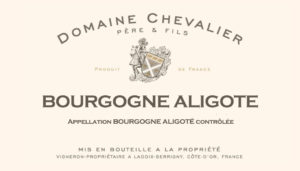
Bourgogne Aligoté
Location: Regional appellation of Burgundy. The appellation Bourgogne Aligoté is restricted to white wines grown from the Aligoté grape
Production Area: 0.82 hectares
Average Age of the Vines: 30 years old
Grape Variety: 100% Aligoté
Vinification: Racking of the must for about 24 hours. The wine is cooled before alcoholic fermentation takes place in vats for a period of 11 months (one part in oaks barrels when available). Fining and light filtration before bottling.
Annual Production: About 6,000 bottles
Tasting Notes: The color is a brilliant gold. The bouquet is vibrant with honeyed aromas of vanilla and hazelnut. The attack is supple and round on the palate with notes of lemon and vanilla.
Serving Temperature: 11-12°C
Food Pairings: Excellent as a pre-dinner aperitif, or mixed with blackcurrant liqueur to become “Kir”. Matches well with grilled fish, oysters, puff pastries, escargot with butter and garlic, and Jambon Persillé, a Burgundian specialty.
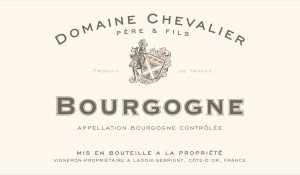
Bourgogne Blanc
Location: Regional appellation; the vineyards are situated in the village of Ladoix Serrigny
Exposition: South and east
Soil: Clay and limestone
Production Area: 0.2 hectares
Average Age of the Vines: 40 years old
Grape Variety: 100% Chardonnay
Annual Production: About 1,400 bottles
Vinification: The wine is vinified in thermo-regulated stainless-steel tanks (16-18°C) and in oak barrels renewed by third every year.
Aging: In oak barrels for 6-7 months with batonnages of the lees
Tasting Notes: Transparent golden color, bright and clear with green reflections. The nose is discreet, fine, fresh, and elegant, with soft and subtle aromas. The wine is fatty on the palate at the start with a good balance between freshness and roundness. Notes of honey and white flowers, with a hint of smokiness. Long finish with a surprising punch of prunelle (plum liqueur).
Serving Suggestions: Excellent as an aperitif or paired with fish or poultry.
Alcohol Content: 13%
Serving Temperature: 10-12°C

Bourgogne Rouge
Location: Regional appellation; from parcels based in the village of Ladoix
Production Area: 0.34 hectares
Grape Variety: 100% Pinot Noir
Annual Production: 3,000 bottles
Vinification: Traditional vinification in vats for 10 days with temperature control. Maturation takes place in oak barrels for 10 months. Bottling in September before or after harvest.
Tasting Notes: This wine has an elegant and refined character as well as a light and fluid structure in the mouth. It is richly colored-crimson when young, and shading towards dark ruby with age. The bouquet has aromas of strawberry, cherry, cassis, and blueberry which evolve into cooked prune, pepper, and earthy notes.
Serving Temperature: 12 to 14° C
Food Pairings: Salads, meat or poultry tarts, and Pot-au-feu (French beef stew)
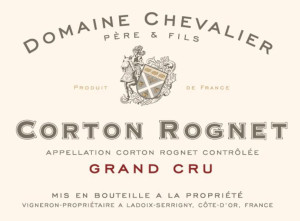
Corton-Rognet Grand Cru
Location: Grand Cru appellation of the Côte de Beaune district. The parcel from which the grapes are harvested, called “Rognet et Corton,” is situated in the village of Ladoix Serrigny
Soil: Chalk and clay
Production Area: 1.15 hectares
Grape Variety: 100% Pinot Noir
Average Age of Vines: 35 years old
Annual Production: 4,500 bottles
Vinification: Traditional vinification; alcoholic fermentation takes place in temperature controlled vats
Aging: Maturation in oak barrels (50% new wood) for 12 months
Tasting Notes: Deep plum color, with a nose that is characterized by notes of black fruit such as cassis and blueberry. The mouth is ample and generous.
Serving Temperature: 14-16°C
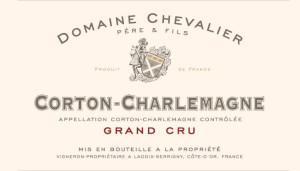
Corton-Charlemagne Grand Cru
Location: Grand Cru appellation located on the hill of Corton, with a wide sunny exposure
Soil: Chalk and clay
Production Area: 0.36 hectares
Grape Variety: 100% Chardonnay
Average Age of Vines: 2 parcels: 10-36 years old
Annual Production: 1,800 bottles
Vinification: Débourbage for 24 hours. The wine is cooled before alcoholic fermentation takes place in oak barrels for a period of 11 months (50% new wood). Fining and light filtration before bottling.
Tasting Notes: Lightly wooded but without excess, excellent body and firmness of constitution thanks to the terroir; more broad on the palate than long lasting; savory notes.
Serving Temperature: Same temperature as the wine cellar
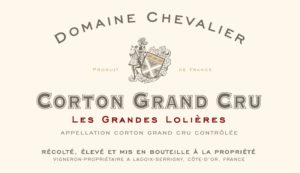
Corton Grand Cru Les Grandes Lolières
Location: Corton “Les Grandes Lolières” is located in the commune of Ladoix. Slightly lower on the hillside than Le Rognet and Corton lieu-dits. Exposed to the south, these vines enjoy the best sunshine.
Production Area: 0.25 hectares
Soil: Clay-limestone
Grape Variety: Pinot Noir
Average Age of the Vines: 50 years
Production: Around 1,000 bottles
Vinification: In vat for 10 days with temperature control.
Aging: In oak barrels for 12 months (33% new wood).
Alcohol: 13.5%
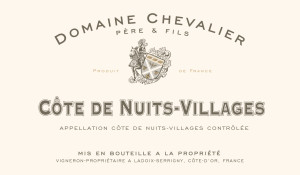
Côte de Nuits Villages
Location: 3 parcels located within the village of Corgoloin
Production Area: 0.01 hectares
Average Age of Vines: 50 years old
Annual Production: About 6,500 bottles
Grape Variety: 100% Pinot Noir
Vinification: Traditional vinification in temperature controlled vats for 10 days; the wine from the 3 parcels is blended at the end of vinification.
Aging: Maturation in oak barrels for 12 months
Tasting Notes: Well constituted wine with a fragrant bouquet that develops complexity with age. Solid cellaring potential.
Serving Temperature: 13-14°C
Food Pairings: Rustic or mousse patés, roasted or fried offal, pork (roasted or in sauce), roasted lamb, braised veal, and cheeses like Epoisses, Langres, and Ami du Chambertin.
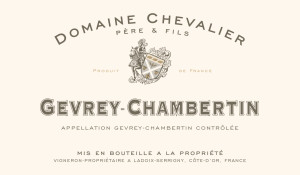
Gevrey-Chambertin
Location: This wine is produced from vines grown in the village of Gevrey Chambertin, in Côte de Nuits.
Production Area: 0.45 hectares
Grape Variety: 100% Pinot Noir
Annual Production: 2,200 bottles
Harvest: The grapes are hand picked at peak maturity. As soon as they are harvested, the grapes are meticulously sorted by a team on the sorting table.
Vinification: The grapes, destemmed slowly to keep them intact, are placed in vats. Then begins the work of vinification: daily monitoring, density measurement, temperature control, and tastings in order to decide on the conduct of the vatting. This is also when they decide on the duration of vatting, which is between 15-21 days depending on the vintage and the expression of the wine sought. The grapes and the musts are cooled prior to a long pre-fermentation maceration in order to extract the fruit of the wine to come. Extractions are slow and gentle thanks to the daily choice, after tasting, of either pigeage, délestage, or remontage. The goal is to create wines full of substance and fruit, reflecting the terroir. After devatting, the pressing is carried out in successive stages with tasting at each stage to decide on the incorporation into the final cuvée.
Aging: The wines are cooled and put into barrels: since 2008, in order to preserve the terroir and the fruitiness of the wines, only wines intended for long aging are aged with a proportion of new barrels, such as the Grands Crus. But all benefit from aging in oak wood, with barrels of 1 to 4 wines. After 10 to 12 months of aging on lees, the wines are then racked and blended in vats. The wines, neither fined nor filtered (with some exceptions) will be bottled at the beginning of the year, following the lunar calendar.
Serving Temperature: 15-16°C
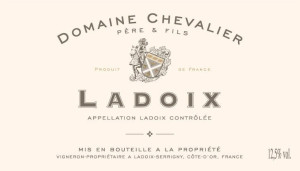
Ladoix Villages Rouge
Location: When coming from the direction of Dijon, it is at Ladoix that the Côte de Beaune begins, right near Aloxe Corton. Ladoix is located in the northern sector of the Côte de Beaune adjoining the Côte de Nuits vineyards. The village lies at the foot of the Coteau de Corton.
Soil: Chalk-marl
Production Area: 3.50 hectares
Grape Variety: 100% Pinot Noir
Average Age of Vines: 45 years old
Annual Production: About 20,000 bottles
Vinification: Traditional vinification in temperature controlled vats for 10 days
Aging: Maturation in oak barrels (25% in 1 year old barrels) for 12 months
Tasting Notes: Supple wine with fine tannins. Very aromatic, with cherry and raspberry notes.
Cellaring Potential: 8-12 years
Serving Temperature: 15-16ºC
Food Pairings: Parma-type hams, fibrous meats with subtle flavors like rabbit or boiled beef, giblets in sauce, feathered game, mild cheeses such as Vacherin, Reblochon, or Cïteaux.

Ladoix Villages Blanc
Location: The village of Ladoix is located north of the Côte de Beaune and the limit of the Côte de Nuits; it lies at the foot of the hill of Corton and the neighboring village of Aloxe Corton. The vineyards are oriented to the east and the southeast.
Production Area: 1.60 hectares
Grape Varieties: 75% Chardonnay; 25% Pinot Blanc
Soil: Clay limestone and marl
Annual Production: 2,000 bottles
Alcohol Content: 13%
Vinification: Débourbage for 24 hours; cooling down; alcoholic fermentation in oak barrels (25% new wood) for 11 months. Collage and light filtration before bottling.
Tasting Notes: Lovely bright golden color, with bouquet of citrus, honey, and sweet hay. The palate is medium-bodied and refreshing, with notes of lemon and stone fruit on the finish, along with gentle spice and hint of vanilla.
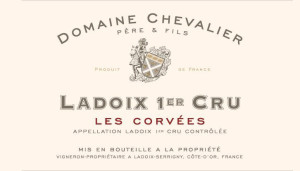
Ladoix Rouge 1er Cru Les Corvées
Location: The vineyard of Corvées is located in the village of Ladoix and faces to the east and southeast which gives good exposure to the vines.
Soil: Clay and chalk
Production Area: 1.85 hectares
Grape Variety: 100% Pinot Noir
Average Age of Vines: The vines used to produce this wine come from 2 parcels and range from 20-70 years old
Annual Production: 9,500 bottles
Vinification: Traditional vinification in temperature controlled vats for 10 days.
Aging: Maturation in oak barrels (25% in 1 year old barrels) for 12 months
Tasting Notes: Ladoix “Les Corvées” is a wine more powerful and racy than Ladoix Village. Beautiful bouquet with oak, pepper, and red fruits flavors. The complexities of this wine come to the fore with maturity.
Cellaring Potential: 8-12 years
Serving Temperature: 15-16°C
Food Pairings: Parma-type hams, fibrous meats with subtle flavors like rabbit or boiled beef, giblets in sauce, feathered game, mild cheeses such as Vacherin, Reblochon, or Cïteaux.
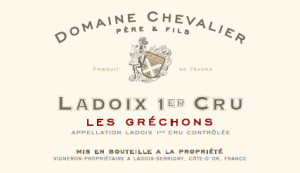
Ladoix Blanc 1er Cru Les Grechons et Foutrières
Location: This wine is produced from vines planted on a limestone hillside; the especially generous exposure makes excellent white wines with great class.
Production Area: 0.70 hectares
Grape Variety: 100% Chardonnay
Average Age of Vines: 17 years old
Annual Production: 3,500 bottles
Vinification: Débourbage for 24 hours. The wine is cooled before alcoholic fermentation in oak barrels (25% new wood) lasting 11 months. Fining and light filtration prior to bottling.
Tasting Notes: The ripeness of the grapes harvested for this wine is expressed on the palate. Very tasty notes of hazelnut praline. Long and racy finish.
Serving Temperature: About 12°C
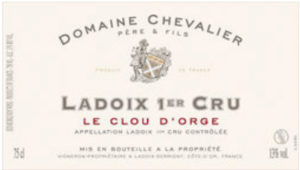
Ladoix 1er Cru Le Clous d'Orge
Location: The vines are planted to the southeast on the climat of “Clou d’Orge.”
Soil: Clay & chalk
Production Area: 0.85 hectares
Grape Variety: 100% Pinot Noir
Average Age of the Vines: 50 years-old
Annual Production: 4,500 bottles
Vinification: Traditional vinification in vats for 10 days with temperature control.
Aging: In oak barrels for 12 months (25% in 1 year old barrles)
Tasting Notes: Ladoix « Le Clou d’Orge » is more powerful and racy than Ladoix Village. Beautiful bouquet with oak, pepper, and ripe red fruit notes. On the palate, this wine is supple, rounded, full and structured with just the right amount of tannins.
Serving Temperature: 15-16°C
Food Pairings: Parma-type hams or fibrous meats with subtle flavors like rabbit. Giblets in sauce or feathered game. It goes well with mild cheeses such as Vacherin, Reblochon, or Cïteaux.


